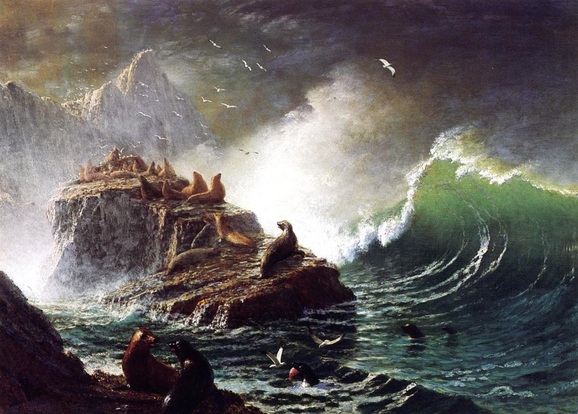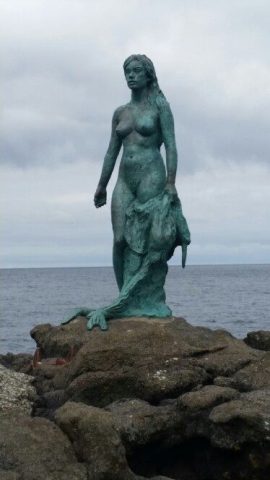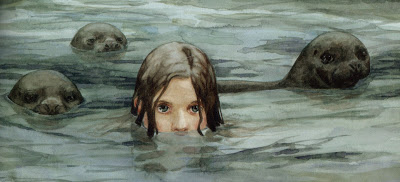Suggestionata dai racconti popolari sulle selkie Marjory Kennedy-Fraser arrangiò un canto in gaelico scozzese delle Isole Ebridi (An Cadal Trom) che è alle origini della fiaba celtica di Mac Codrum delle Foche e lo intitolò The Seal-woman croon
[Traduzione inglese]
Marjory Kennedy-Fraser , influenced by the folk tales on the selkie, arranged a Scottish Gaelic song of the Hebrides (An Cadal Trom) that is at the origins of the Celtic tale “Mac Codrum of the Seals” (to read in English here) and she titled as “The Seal-woman croon”
MacCodrum delle Foche
Il re e la regina del Mare del Nord (la leggenda dice che il loro regno si trovava in Norvegia nella Terra di Lochlan), vivevano felici con i loro numerosi figli, ma la regina morì, così nessuno si prendeva più cura dei principini e delle principessine; il re decise di risposarsi, chiedendo in sposa una misteriosa strega marina che viveva in una oscura foresta sul fondo dell’oceano. Date le premesse la matrigna non poteva che essere gelosa dei figli del re e per pura cattiveria trasformò i loro splendidi corpi in foche, condannandoli a nuotare tra i sette mari durante tutto l’anno.
Neppure il re riuscì a sciogliere il maleficio, i suoi figli potevano riprendere la loro forma originaria solo per un unico giorno dell’anno dal tramonto del sole e fino al crepuscolo successivo (in alcune versioni della leggenda sono invece le notti di luna piena dell’anno). Così le foche cantavano la loro disperazione per il maleficio che le condannava a fuggire dal padre e dal loro reame per vagare nei mari del mondo.
Accadde che un pescatore dell’isola di Bernaray nelle Ebridi Esterne di nome Roderic MacCodrum del clan dei Donald udisse un giorno un canto proveniente dalle rocce vicino alla scogliera, dove vide i figli e le figlie del Re del Mare ritornati in forma umana. (tutta la fiaba in Fiabe Celtiche F. Fornaciani)

Contrariamente alla versione in cui il pescatore nasconde la pelle di foca per legare a sè la selkie e convincerla a sposarlo, in The Seal-woman croon la restituisce al mare e ai suoi simili, così descrive la leggenda Kenneth MacLeod riportandola nel libro “Songs of the Hebrides” a compendio della canzone “An cadal trom”.
Le foche sono i figli del re di Lochlann sotto un incantesimo. La bellezza, la saggezza e il coraggio erano nel loro sangue e nella loro pelle, e fu perciò che la loro matrigna decise di distruggerli, e che non sarebbe vissuta a meno di liberarsi di loro. Sette lunghi anni trascorse con un mago, per imparare la Magia Nera, finché alla fine fu brava come il suo padrone, in aggiunta all’arguzia di donna. E cosa ne pensate! La terribile megera mise i suoi figliastri sotto un eterno incantesimo per metà-bestia e per metà pesce fino a quando le onde si frangeranno sulle coste di Lochlann!
Un’azione malvagia invero- dovreste sapere dagli occhi delle foche, che c’è sangue regale in loro. Ma il peggio deve ancora venire. Tre volte all’anno, quando la luna piena è più brillante, le foche devono tornare al loro stato naturale, che lo vogliano o no. La matrigna ha fatto l’incantesimo in modo che ci fosse invidia e dolore nei loro cuori ogni qualvolta vedevano altri governare il regno che era loro per diritto di sangue. E se vi capitasse di vedere uno di loro come dovrebbe essere sempre, v’innamorereste all’istante, e se i vostri pensieri fossero rivolti al matrimonio, di certo ci sarà un matrimonio.
Molto tempo fa, e tuttavia non molto tempo fa, un uomo di Canna vagava sulla spiaggia in una notte d’autunno con la luna piena, e chi ti vide se non una donna-foca che si lavava nella corrente! E come ho detto, il suo cuore si innamorò di lei, e lui le andò vicino e l’affascinò con lo sguardo, facendola cadere in un sonno profondo, e la portò a casa tra le sue braccia.
Ma quando lei si risvegliò lui vide solo una foca! Facendo ricorso a tutta la sua bontà d’animo, con il cuore mosso a compassione, lui la portò giù al mare e la lasciò andare a nuoto verso i suoi consimili, dove avrebbe dovuto stare. E lei trascorse quella notte, si dice, su una scogliera vicino al mare, cantando come a perdifiato, e questo è uno dei suoi lamenti- anzi, tutte le foche cantano bene, e se appartengono alla stirpe di Lochlann, è il gaelico che preferiscono!

[Traduzione inglese]
Contrary to the version in which the fisherman hides the seal skin to tie the selkie to himself and convince her to marry him, in The Seal-woman croon he returns her to the sea and to his fellows; here is Kenneth MacLeode who describes the legend , in the book “Songs of the Hebrides” as compendium of the gaelic song “An cadal trom” (Deeply sleep).
The seals are the children of the King of Lochlann under spells — Clann Righ Lochlainn fo gheasaibh. Beauty, wisdom and bravery were in their blood as well as in their skins, and that was why their step-mother took the bate of destruction for the, and live she would not unless she got them out of the way. Seven long years did she spend with a namely magician, a-learning of the Black Arts, until at last she was as good as her master at it, with a woman’s wit, forby. And what think ye of it! Did not the terrible carlin put her step-children under eternal spells that they should be half-fish half-beast so long as waves should beat on the shores of Lochlann!
Och! Och! That was the black deed — sure you would know by the very eyes of the seals that there is a kingly blood in them. But the worst is still untold. Three times in the year, when the full moon is brightest, the seals must go back to their own natural state, whether they wish it or no. Their step-mother put this in the spells so that there might be a world of envy and sorrow in their hearts every time they saw others ruling in the kingdom which is theirs by right of blood. And if you were to see one of them as they should be always, if right were kept, you would take the love of your heart for that one, and if weddings were in your thoughts, sure enough a wedding there would be.
Long ago, and not so long ago either, a man in Canna was shore-wandering on an autumn night and the moon full, and did he not see one of the seal lady-lords washing herself in a streamlet that was meeting the waves! And just as I said, he took the love of his heart for her, and he went and put deep sleep on her with a sort of charm that he had, and he carried her home in his arms. But och! och! when she wakening came, what had he before him but a seal! And though he needed all the goodness he had, love put softening in his heart, and he carried her down to the sea and let her swim away to her own kith and kin, where she ought to be. And she spent that night, it is said, on a reef near the shore, singing like a daft mavis, and this is one of her croons — indeed, all the seals are good at the songs, and though they are really of the race of Lochlann, it is the Gaelic they like best.

An Cadal Trom
Chorus
Bheir mi hiù-ra bho nail-e bho (1)
Bheir mi hiù-ra bho nail-e bho ho ro
Bheir mi hiù-ra bho nail-e bho
An cadal trom ‘san deachaidh mi
I
Tha mo chlu-as ag an cras gail dhonn
Anns an lonn ar-as gheal o ho
Tha mo dhuan ag an gair-iéh thonn
‘Se’n cad-al trom a dhealaich sinn.
II
Tha mo ghru-ag ach-sa fa-da thall
Air na dàimh sgeir-e gheal o hi
Fàth mo ghruamain gu’n d’rinn mi chall
‘Se’n cad-al trom a dhealaich sinn.
III
Bidh mi mair each a’ snamh nan tonn
Thar an lonn ar-as gheal o hi
Ni mi àbh achd le gràdh-an donn
An cad-al trom cha dhealaich sinn
The Seal-woman croon
Kenneth MacLeod version
Chorus
Bheir mi hiù-ra bho nail-e bho (1)
Bheir mi hiù-ra bho nail-e bho ho ro
Bheir mi hiù-ra bho nail-e bho
An cadal trom ‘san deachaidh mi (2)
I
Pillowed on the sea-wrack (3), brown am I (4)
On the gleaming white-sheen sand
Lulled by the sweet croon of the waves I lie
Did slumber deep, part thee and me (5)
II
Far away, my own gruag-ach (6) lone
On the gleaming white-friend reefs
Lies that cause of all my moan
Did slumber deep, part thee and me
III
On the morrow shall I, o’er the sound (7)
O’er the gleaming white-sheen sand
Swim until I reach my loved one brown
Nor slumber deep, part thee and me
FOOTNOTES
1) non sense verses
2) in english “the deep sleep into which I went”
3) seaweed cast ashore in masses [
4) she is a ‘dark one.’ Unlike the many irish blondes (or with red hair), a selkie is a true ‘black Irish’ with dark long hair, wavy, full curls, skin as porcelain, and striking dark eyes
5) deachaidh =Go, proceed, move, travel, walk. – to fall; the sentence has an interrogative form; sunn= we, us
6) “The long-haired one” and also sea maiden from the Gaelic “gruag, gruagach”
7) sound geography: is a large sea or ocean inlet
Il canto della Selkie
Traduzione italiana Cattia Salto
Coro
Bheir mi hiù-ra bho nail-e bho
Bheir mi hiù-ra bho nail-e bho ho ro
Bheir mi hiù-ra bho nail-e bho
il sonno profondo in cui sono caduta
I (Foca)
Avvolta nelle alghe a terra, scura sono
sulla serica sabbia bianca scintillante
cullata dal dolce mormorio delle onde rimango,
dormire profondamente o separarci?
II (pescatore)
Lontano la mia fanciulla solitaria
sulla bianca scogliera amica scintillante
giace la causa del mio lamento:
dormire profondamente o separarci?
III (foca)
Domani dovrò, oltre la baia,
oltre la serica sabbia bianca scintillante,
nuotare fino a raggiungere i miei amati scuri
non dormirò e ci separeremo
NOTE
1) i vocalizzi sono in simil gaelico e non hanno un significato
3) le alghe spinte dal mare sulla spiaggia
4) A differenza delle molte bionde irlandesi (o con i capelli rossi), una selkie è un’irlandese “scura” autentica, con capelli scuri lunghi, ondulati e ricci, pelle di porcellana e intensi occhi scuri
LINK
http://ontanomagico.altervista.org/sule-skerry.htm
https://terreceltiche.altervista.org/gruagach-mhara-a-gruagach-or-a-selkie/
https://www.electricscotland.com/POETRY/purves/MacCodrum.pdf
http://echoes.devin.com/selkie/croon.html
